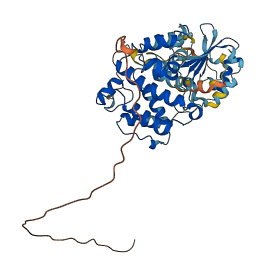Q8IZM6
Gene name |
BPGAP1 |
Protein name |
BCH domain-containing Cdc42GAP-like protein |
Names |
|
Species |
Homo sapiens (Human) |
KEGG Pathway |
|
EC number |
|
Protein Class |
RHO GTPASE-ACTIVATING PROTEIN 68F (PTHR45808) |

Descriptions
BCH domain-containing Cdc42GAP-like protein (BPGAP1) is a multidomain Rho GTPase-activating protein (RhoGAP) that promotes Erk activation and cell motility. The unphosphorylated C-terminus of BPGAP1 binds to its N-terminus to inhibit its function, but this inhibitory effect can be removed upon phosphorylation at Ser424 by JNK. In addition, the DDYGD motif of RhoGAP domain interacts with PRR motif, thereby inhibits the binding of PRR motif to WW domain of Pin1.
Autoinhibitory domains (AIDs)
Target domain |
186-189 (PRR motif) |
Relief mechanism |
Partner binding |
Assay |
Deletion assay |
Target domain |
186-189 (PRR motif) |
Relief mechanism |
PTM |
Assay |
Mutagenesis experiment |
Accessory elements
No accessory elements
References
- Pan CQ et al. (2010) "Active Mek2 as a regulatory scaffold that promotes Pin1 binding to BPGAP1 to suppress BPGAP1-induced acute Erk activation and cell migration", Journal of cell science, 123, 903-16
- Jiang T et al. (2017) "BPGAP1 spatially integrates JNK/ERK signaling crosstalk in oncogenesis", Oncogene, 36, 3178-3192
- Wong DCP et al. (2023) "The scaffold RhoGAP protein ARHGAP8/BPGAP1 synchronizes Rac and Rho signaling to facilitate cell migration", Molecular biology of the cell, 34, ar13
Autoinhibited structure

Activated structure

1 structures for Q8IZM6
| Entry ID | Method | Resolution | Chain | Position | Source |
|---|---|---|---|---|---|
| AF-Q8IZM6-F1 | Predicted | AlphaFoldDB |
No variants for Q8IZM6
| Variant ID(s) | Position | Change | Description | Diseaes Association | Provenance |
|---|---|---|---|---|---|
| No variants for Q8IZM6 | |||||
No associated diseases with Q8IZM6
No regional properties for Q8IZM6
| Type | Name | Position | InterPro Accession |
|---|---|---|---|
| No domain, repeats, and functional sites for Q8IZM6 | |||
Functions
| Description | ||
|---|---|---|
| EC Number | ||
| Subcellular Localization |
|
|
| PANTHER Family | PTHR45808 | RHO GTPASE-ACTIVATING PROTEIN 68F |
| PANTHER Subfamily | PTHR45808:SF4 | RHO GTPASE-ACTIVATING PROTEIN 8 |
| PANTHER Protein Class | GTPase-activating protein | |
| PANTHER Pathway Category |
VEGF signaling pathway Rac Angiogenesis Rac Cytoskeletal regulation by Rho GTPase Rho GAPs PDGF signaling pathway Rho |
|
No GO annotations of cellular component
| Name | Definition |
|---|---|
| No GO annotations for cellular component |
1 GO annotations of molecular function
| Name | Definition |
|---|---|
| GTPase activator activity | Binds to and increases the activity of a GTPase, an enzyme that catalyzes the hydrolysis of GTP. |
3 GO annotations of biological process
| Name | Definition |
|---|---|
| actin cytoskeleton organization | A process that is carried out at the cellular level which results in the assembly, arrangement of constituent parts, or disassembly of cytoskeletal structures comprising actin filaments and their associated proteins. |
| positive regulation of cell migration | Any process that activates or increases the frequency, rate or extent of cell migration. |
| signal transduction | The cellular process in which a signal is conveyed to trigger a change in the activity or state of a cell. Signal transduction begins with reception of a signal (e.g. a ligand binding to a receptor or receptor activation by a stimulus such as light), or for signal transduction in the absence of ligand, signal-withdrawal or the activity of a constitutively active receptor. Signal transduction ends with regulation of a downstream cellular process, e.g. regulation of transcription or regulation of a metabolic process. Signal transduction covers signaling from receptors located on the surface of the cell and signaling via molecules located within the cell. For signaling between cells, signal transduction is restricted to events at and within the receiving cell. |
No homologous proteins in AiPD
| UniProt AC | Gene Name | Protein Name | Species | Evidence Code |
|---|---|---|---|---|
| No homologous proteins | ||||
| 10 | 20 | 30 | 40 | 50 | 60 |
| MAGQDPALST | SHPFYDVARH | GILQVAGDDR | FGRRVVTFSC | CRMPPSHELD | HQRLLEYLKY |
| 70 | 80 | 90 | 100 | 110 | 120 |
| TLDQYVENDY | TIVYFHYGLN | SRNKPSLGWL | QSAYKEFDRK | YKKNLKALYV | VHPTSFIKVL |
| 130 | 140 | 150 | 160 | 170 | 180 |
| WNILKPLISH | KFGKKVIYFN | YLSELHEHLK | YDQLVIPPEV | LRYDEKLQSL | HEGRTPPPTK |
| 190 | 200 | 210 | 220 | 230 | 240 |
| TPPPRPPLPT | QQFGVSLQYL | KDKNQGELIP | PVLRFTVTYL | REKGLRTEGL | FRRSASVQTV |
| 250 | 260 | 270 | 280 | 290 | 300 |
| REIQRLYNQG | KPVNFDDYGD | IHIPAVILKT | FLRELPQPLL | TFQAYEQILG | ITCVESSLRV |
| 310 | 320 | 330 | 340 | 350 | 360 |
| TGCRQILRSL | PEHNYVVLRY | LMGSLHAVSR | ESIFNKMNSS | NLACVFGLNL | IWPSQGVSSL |
| 370 | 380 | 390 | 400 | 410 | 420 |
| SALVPLNMFT | ELLIEYYEKI | FSTPEAPGEH | GLAPWEQGSR | AAPLQEAVPR | TQATGLTKPT |
| 430 | |||||
| LPPSPLMAAR | RRL |